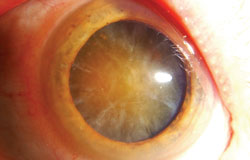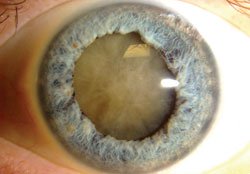Dense brunescent cataracts present surgical challenges
Despite the greater risk for complications with this type of surgery, patients tend to be happy afterward because of the vast improvement in vision.
 Uday Devgan |
Among the most difficult cases for phacoemulsification is the dense brunescent cataract. Due to the increased nuclear density, the cataract surgery requires more effort, energy and attention to successfully complete. The patients are at a higher risk for complications, but they are often the most grateful because they can go from legally blind back to normal vision that will allow them to resume their normal activities of daily life.
Preoperative examination
The patients present with a long-standing history of markedly decreased vision that has slowly deteriorated over the years. These patients typically have visual acuities worse than 20/200, and both eyes tend to be affected relatively equally. The patients are often older and may have coexisting ocular pathology or conditions that can affect the final visual outcome.
A careful slit lamp microscope exam can detect corneal endothelial weakness, a shallow anterior chamber and signs of lens zonular laxity. The density and opacity of the nucleus may preclude a clear view of the posterior segment of the eye and an ultrasonic examination may be required. Patients with very dense cataracts often have not received medical eye care for years to decades, and there can be occult comorbidities such as glaucoma, macular degeneration or retinal disease.
Biometry can be a challenge as well because optical methods of axial length determination may not be able to penetrate the cataract. Similarly, the patient may have trouble fixating on a target during keratometry readings. Because of the severe visual deficit, these patients tend to be very forgiving of any residual refractive error, and we can further enhance useful vision by leaning toward a myopic result should there be any issues with lens calculations.
Intraoperative techniques
In parts of the world where these dense cataracts are common and access to advanced technology platforms is limited, the technique of manual extraction of the undivided nucleus is preferred. It is an excellent technique that preserves the corneal endothelial cells and simplifies the surgery, but it comes at the cost of a large incision, which induces significant astigmatism. For this reason, we will focus our discussion on phacoemulsification of these dense cataracts.
 This brunescent cataract has a central zone of increased density that will require more phaco energy to emulsify. |
 With the high degree of lens opacity, capsular staining will be necessary in order to visualize the creation of the capsulorrhexis. Images: Devgan U |
The phaco incision can be made in either the sclera or the cornea, but there is a risk of corneal wound burn with the higher amount of phaco energy used in removing a dense cataract. A slightly leaky incision will allow the balanced salt solution to keep the corneal incision cooled, but a scleral tunnel incision has the benefit of potential enlargement should the surgeon wish to convert to a manual extraction method. Due to poor visibility, the use of trypan blue dye to stain the anterior capsule may be required to create a continuous curvilinear capsulorrhexis.
The primary difficulty in performing phacoemulsification on a dense cataract is the amount of energy and effort required to break up the nucleus for aspiration. With increasing amounts of ultrasonic energy being delivered into the eye, it is important to minimize the trauma to the corneal endothelial cells to prevent pseudophakic bullous keratopathy after surgery. This can be accomplished by decreasing the phaco power delivered as well as using a viscoelastic substance to protect the corneal endothelium.
Phaco power modulations are methods of programming a phaco machine to deliver ultrasonic energy in packets or pulses, thereby allowing efficient surgery with less energy. The primary modulations are pulse mode and burst mode, both of which serve to deliver less energy than default continuous mode. Start with an initial setting of a 50% duty cycle for pulse mode and titrate higher for more cutting power or lower for less. Methods of mechanical nucleus disassembly such as phaco chop or pre-chop allow the surgeon to break apart the dense nucleus into quadrants while minimizing ultrasonic energy. These pieces are brought to the iris plane and then emulsified with phaco energy.
The distance from the phaco probe to the corneal endothelium makes a significant difference as explained by the inverse square law: The phaco energy absorbed by the cornea is inversely proportional to the square of the distance. If we keep the phaco probe within the capsular bag and farther away from the cornea, we will better protect the endothelium from damage. Because the central core of the nucleus tends to be the toughest and densest, using a nucleus sculpting technique such as creating a central groove can debulk the cataract while staying farther away from the endothelium. After the central core of the nucleus is removed, the remaining cataract can be chopped and emulsified.
A dispersive viscoelastic is important to coat and protect the corneal endothelium. The fluidics of phacoemulsification can wash away this coating, so periodic reapplication of viscoelastic during surgery is recommended along with lowering the flow rate to 30 cc or less per minute.
Postoperative course
Because these patients are expected to have more postoperative inflammation than patients with average cataracts, a longer course of steroids and NSAIDs is recommended. The patients may have corneal edema in the immediate postop period, but this tends to resolve within a few weeks. A degree of corneal endothelial cell loss is expected, even when the phacoemulsification surgery is performed by the most skilled and experienced surgeons. With a huge improvement in vision, the patients are uniformly very happy after cataract surgery.

- Uday Devgan, MD, FACS, FRCS(Glasg), is in private practice at Devgan Eye Surgery in Los Angeles, Beverly Hills and Newport Beach, Calif. He is also chief of ophthalmology at Olive View UCLA Medical Center and associate clinical professor at the UCLA School of Medicine. He can be reached at 11600 Wilshire Blvd., Suite 200, Los Angeles, CA 90025; 800-337-1969; fax 310-388-3028; email: devgan@gmail.com; website: www.devganeye.com.
- Disclosure: No products or companies are mentioned that would require financial disclosure.
